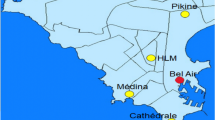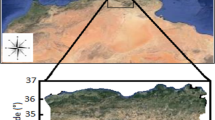Abstract
Measurement of evaporation (E) rate from various natural surfaces is known as the key element in any hydrological cycle and hydrometeorological studies. Due to the shortage of pan evaporation (E P) data, the estimation of E P for such studies seems necessary. The main aim of this paper was to estimate daily E P using artificial neural network (ANN) and multivariate non-linear regression (MNLR) methods in semi-arid region of Iran. Five different ANN and MNLR models comprising various combinations of daily meteorological variables, that is, relative humidity (RH), air temperature (T), solar radiation (SR), wind speed (U) and precipitation (P) were developed to evaluate degree of effect of each of these variables on E P. The comparison of models estimates showed that the ANN 5 model characterized by Delta-Bar-Delta learning algorithm and Sigmoid activation function which uses all input parameters (T, U, SR, RH, P) performed best in prediction of daily E P. The sensitivity analysis revealed that the estimated E P data are more sensitive to T and U, respectively. A comparison of the model performance between ANN and MNLR models indicated that ANN method presents the best estimates of daily E P.




Similar content being viewed by others
References
Bruton JM, Mcclendon RW, Hoogenboom G (2000) Estimating daily pan evaporation with artificial neural networks. Trans ASAE 43(2):491–496
Chakraborty B, Chakraborty G (2002) A new feature extraction technique for on-line recognition of handwritten alphanumeric characters. Inform Sci 148:55–70
Dawson CW, Abrahart RJ, Shamseldin AY, Wilby RL (2006) Flood estimation at ungauged sites using artificial neural networks. J Hydrol 319:391–409
Deswal S, Pal M (2008) Artificial neural network based modeling of evaporation losses in reservoirs. Proc World Acad Sci Eng Technol 29:279–283
Doorenbos J, Pruitt WO (1977) Guidelines for prediction of crop water requirements. FAO Irrig Drain. Paper no. 24, Rome
Eslamian SS, Gohari SA, Biabanaki M, Malekian R (2008) Estimation of monthly pan evaporation using artificial neural networks and support vector machines. J Appl Sci 8(19):3497–3502
Gundekar HG, Khodke UM, Sarkar S (2008) Evaluation of pan coefficient for reference crop evapotranspiration for semi-arid region. Irrig Sci 26:169–175
Haciismailoglu MC, Kucuk I, Derebasi N (2009) Prediction of dynamic hysteresis loops of nano-crystalline cores. Expert Syst Appl 36:2225–2227
IRIMO (2007) Iranian meteorological office. Data Processing Center, Tehran, Iran
Jalali-Heravi M, Asadollahi-Baboli M, Shahbazikhah P (2008) QSAR study of heparanase inhibitors activity using artificial networks and LevenbergeMarquardt algorithm. Eur J Med Chem 43:548–556
Jensen ME, Burman RD, Allen RG (1990) Evapotranspiration and irrigation water requirements. ASCE manuals and reports on engineering practice no. 70, New York, 332 pp
Kazanasmaz T, Gunaydin M, Binol S (2009) Artificial neural networks to predict daylight illuminance in office buildings. Build Environ 44:1751–1757
Keskin ME, Terzi O (2006) Artificial neural network models of daily pan evaporation. J Hydrol Eng 11(1):65–70
Kim S, Kim HS (2008) Neural networks and genetic algorithm approach for nonlinear evaporation and evapotranspiration modeling. J Hydrol 351:299–317
Kisi O (2006) Daily pan evaporation modeling using a neuro-fuzzy computing technique. J Hydrol 329:636–646
Kumar M, Raghuwanshi NS, Singh R, Wallender WW, Pruitt WO (2002) Estimating evapotranspiration using artificial neural network. J Irrg Drain Eng 128(4):224–233
Leahy P, Kiely G, Corcoran G (2008) Structural optimisation and input selection of an artificial neural network for river level prediction. J Hydrol 355:192–201
Molina Martinez JM, Martinez Alvarez V, Gonzalez-Real MM, Baille A (2005) A simulation model for predicting hourly pan evaporation from meteorological data. J Hydrol 318:250–261
NeuroSolutions (2003) The neural network simulation environment. NeuroDimension Inc., FL USA
Rahimi Khoob A (2009) Estimating daily pan evaporation using artificial neural network in a semi-arid environment. Theor Appl Climatol 98:101–105
Razi MA, Athappilly K (2005) A comparative predictive analysis of neural networks (NNs), nonlinear regression and classification and regression tree (CART) models. Expert Syst Appl 29:65–74
Sabziparvar AA, Tabari H, Aeini A, Ghafouri M (2009) Evaluation of class A pan coefficient models for estimation of reference crop evapotranspiration in cold-semi arid and warm arid climates, Water Resour Manage. doi:10.1007/s11269-009-9478-2
Sharda R, Delen D (2006) Predicting box-office success of motion pictures with neural networks. Expert Syst Appl 30:243–254
Sudheer KP, Gosain AK, Rangan D, Saheb SM (2002) Modeling evaporation using an artificial neural network algorithm. Hydrol Process 16:3189–3202
Sudheer KP, Gosain AK, Ramasastri KS (2003) Estimating actual evapotranspiration from limited climate data using neural computing technique. J Irrg Drain Eng 129(3):214–218
Tabari H, Aieni A, Sabziparvar AA, Marofi S (2008) Comparison of non-linear regression and artificial neural network for estimation of daily Class A pan evaporation in a semi-arid region. 3rd Iran water resources management conference, Tabriz University, October 14–16, Tabriz, Iran (in Persian)
Tabari H, Shadmani M, Sabziparvar AA, Marofi S (2009) Comparison of non-linear regression and artificial neural network and empirical methods in estimating daily Class A pan evaporation in a semi-arid region. 1st International conference of water crisis, Zabol University, 10–12 March, Zabol, Iran (in Persian with English abstract)
Terzi O, Keskin ME (2005) Modelling of daily pan evaporation. J Appl Sci 5(2):368–372
Trajkovic S, Todorovic B, Stankovic M (2003) Forecasting of reference evapotranspiration by Artificial Neural Network. J Irrg Drain Eng 129(6):454–457
Acknowledgments
The authors wish to thank the Islamic Republic of Iran Meteorological Organization (IRIMO) for providing the requisite meteorological data. The authors express their gratitude to the Bu-Ali Sina University for their supports. Special thanks are due to the useful comments and suggestions of editor and two anonymous reviewers.
Author information
Authors and Affiliations
Corresponding author
Additional information
Communicated by A. Kassam.
Rights and permissions
About this article
Cite this article
Tabari, H., Marofi, S. & Sabziparvar, AA. Estimation of daily pan evaporation using artificial neural network and multivariate non-linear regression. Irrig Sci 28, 399–406 (2010). https://doi.org/10.1007/s00271-009-0201-0
Received:
Accepted:
Published:
Issue Date:
DOI: https://doi.org/10.1007/s00271-009-0201-0




